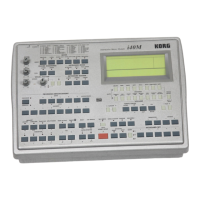Reference • Arrangement Play mode
56
6. Arrangement Play mode
Tempo and chord scanning
The tempo and recognized chords are always shown
at the top of the display.
= (Tempo)
[40…240]
Adjust the tempo using the TEMPO/VALUE buttons.
Alternatively, you can define the tempo by tapping it
on TAP TEMPO.
40-240 Normal metronome tempo expressed
in BPM (Beat Per Minute).
EXT External Synchronism. Automatically
selected if the Clock Source parame-
ter in the Disk/Global mode is on
MIDI IN 1 or MIDI IN 2. Start/Stop
and tempo are controlled by an
external device connected via MIDI
(sequencer, keyboards).
Name of the chords
When the instrument detects a chord, its abbreviation
appears on the display. The chords control the
arrangement patterns.
The notes for chord detection must be received over
the special Global, Chord 1 and Chord 2 channels (see
“The special channels” on page 45).
The notes for the chord detection that arrive on Chord
1 and Chord 2 channels have no extension limits. The
notes that arrive on the Global channel are affected by
the split point and the status of the CHORD SCAN-
NING section.
• Chord Scanning LOWER: detects chords below the
split point. The detection mode depends on the
“ChordRecog (Chord recognition mode)” parame-
ter (see page 147).
• Chord Scanning UPPER: detect chords above the
split point. The detection mode is always “Fingered
2” (see page 147), that requires chords of at least
three notes.
• Chord Scanning FULL: detect chords on the entire
keyboard. The detection mode is always “Fingered
2” (see page 147), that requires chords of at least
three notes.
In order to program the split point, hold down the
SPLIT POINT button and play the note you with to set
as split point.
The detected chord stays in memory, even if you
change the arrangement while the accompaniment is
playing. You can reset the chord scanning by pressing
RESET, or by selecting an arrangement with the
accompaniment stopped.
Tempo Chord name

